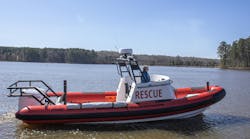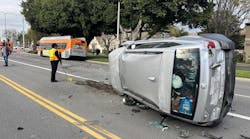Aug. 02--Authorities spent most of Thursday searching for three men who drowned while "noodling" for fish in Zink Lake on the Arkansas River.
The three, all in their 20s and students at Tulsa Welding School, were swept under water by the strong current near the low-water dam under the pedestrian bridge early Thursday.
Tulsa police officers and firefighters began searching the river near 31st Street and Riverside Drive shortly after 5 a.m.
Fire Capt. Stan May said Eric Harris, 27 of Tulsa; Troy George, 23, of Louisiana; and Conner Norvel, 20, of Colorado were noodling -- hand fishing -- about 3:30 a.m. when they were swept under water.
They were fishing above the low-water dam when one person got too close to the dam and went over, and "two of his friends went in after him," May said.
There was a "really bad riptide. ... Experienced swimmers with life jackets lose their life in something like that," May said.
The first call to emergency officials was received at 5:13 a.m., and police arrived at 5:21 a.m., according to a Police Department spokesman.
Several rescue boats were dispatched in addition to a helicopter to search for the missing men.
Officials' search was slowed until the water receded. The U.S. Army Corps of Engineers controls the flow into the river from the Keystone Dam west of Sand Springs, and that flow was reduced. Rescuers continued searching the river banks through the afternoon and launched an airboat at 3:15 p.m. to continue the search on the water.
Several distraught people gathered at the river's edge as searchers tried to find the missing men.
George's body was recovered about 7:30 a.m., approximately half a mile south of the low-water dam.
Norvel's body was recovered under the low-water dam about 3:35 p.m. He was found about 15 to 20 feet from where the three men went into the water.
Harris' body was discovered by divers about 5:45 p.m. near the AEP-PSO power plant about a half-mile south of the dam.
Their group of seven men and women had gone to the river early Thursday, one of them said.
"It was a spur-of-the-moment thing," said Bryan Tillman, who was in the group.
"I tried to warn them" about getting too close to the dam, Tillman said.
He and the other men attended the Tulsa Welding School, he said.
"They're good people," Tillman said. "(I) met them in January. We were all just friends."
The group had noodled before but never late at night, he said.
"I don't know what they were thinking," Tillman said. "I saw that water and said, 'That's too fast."
A city ordinance establishing safety zones makes it illegal to swim or boat within 400 feet upstream or within 150 feet downstream of the dam. In addition, River Parks maintains a curfew from 11 p.m. to 5 a.m.
Noodling in the area is uncommon and not recommended, said Brent Gordon, regional fishery supervisor with the Oklahoma Department of Wildlife Conservation.
"Low-water dams are known ... as killing machines because they are," he said.
Gordon advises noodlers to handfish in area lakes instead. Prairie rivers, such as the Arkansas, tend to rise quickly, he said.
"That water comes up, and it comes up faster than you can imagine," he said.
Noodling at night can be especially dangerous due to decreased visibility, both of the angler and of others in the area who could help in times of distress, Gordon said.
Army Corps of Engineers spokesman Ross Adkins said the dam was releasing 12,000 cubic feet of water per second early Thursday. The corps had planned to increase the water flow to 18,000 cubic feet per second later that day before rescue and recovery efforts were launched.
"When (the water) changes directions (at the low-water dam), it really kind of starts to roll, and that actually becomes an undertow then. ... It's going to capture and hold you," Adkins said.
The water level in an upstream basin connected to Lake Keystone and the Arkansas River was high because of rain early this week. Meteorology services measured between 1.04 and 1.23 inches of rain in Tulsa between Monday night and Tuesday morning.
Tulsa World archives show that before Thursday, at least 14 people had drowned in the area since the dam's construction in 1983.
World Staff Writer Sara Plummer contributed to this story.
Kendrick Marshall 918-581-8386 Amanda Bland 918-581-8413
[email protected] [email protected]
Copyright 2013 - Tulsa World, Okla.





